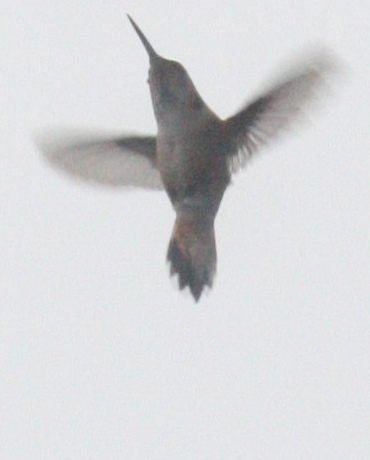Through the evening I repeatedly heard a loud, snarling buzz, like a tiny chainsaw, at floor-level. It was always on the far side of a divider, and always gone when I investigated.
What was my surprise when I noticed, first, a tiny Anna's female perched on a branch of the walnut, watching intently, waiting for me to piss off. Later, I caught a glimpse of her hovering one wing-length above the barn floor, fixing the powdery dirt, sawdust, and manure with laser intent. She was not gathering nest material; Anna's hummingbirds nest in December, and she was far too bent upon this errand for that.
I would see this behaviour throughout the first half of the ango, ending only when the birds themselves became scarce in August. And I would eventually learn what they were up to: hummingbirds, while often thought to run on sugar and water, are in fact ultra high-tech
aircraft with exacting requirements. Among these are molecular amendments of calcium, magnesium, potassium, and electrolytes absent from the nectar and insects they burn like booster rockets. I've even had hummingbirds hover hungrily over my stream while I urinate; atomic metabolism makes the gush of trace elements hypnotic. (No takers to date, though.)
Hence my little neighbours' fascination with the barn floor: they were shipping minerals from a standing hover, their threadlike tongues flicking in and out almost faster than the eye could see. Vital ordnance, no doubt.
What was my surprise when I noticed, first, a tiny Anna's female perched on a branch of the walnut, watching intently, waiting for me to piss off. Later, I caught a glimpse of her hovering one wing-length above the barn floor, fixing the powdery dirt, sawdust, and manure with laser intent. She was not gathering nest material; Anna's hummingbirds nest in December, and she was far too bent upon this errand for that.
I would see this behaviour throughout the first half of the ango, ending only when the birds themselves became scarce in August. And I would eventually learn what they were up to: hummingbirds, while often thought to run on sugar and water, are in fact ultra high-tech
aircraft with exacting requirements. Among these are molecular amendments of calcium, magnesium, potassium, and electrolytes absent from the nectar and insects they burn like booster rockets. I've even had hummingbirds hover hungrily over my stream while I urinate; atomic metabolism makes the gush of trace elements hypnotic. (No takers to date, though.)
Hence my little neighbours' fascination with the barn floor: they were shipping minerals from a standing hover, their threadlike tongues flicking in and out almost faster than the eye could see. Vital ordnance, no doubt.



I never knew that hummingbirds went for anything other than flower nectar and occasional human provided sugar water. Here is a link to a neat video of hummingbird tongues in action:
ReplyDeletehttp://www.wired.com/wiredscience/2011/05/hummingbird-tongue-drinking/
p.s. - There is a typo in your last paragraph. "sHipping"
Nope, it's "shipping", Will. Navy term. (Plus you wouldn't sip minerals from a dirt floor, eh?) But thanks for the warning; I obsess over typos. If you see any others on this site, please point them out.
ReplyDeleteYeah, hummingbirds actually mostly live on insects. The sugar water is just booster fuel. Most people don't know that, because all we see is the liquid part of their diet.
Thanks for the link!